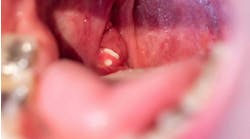Sitting in the front row of my kindergarten class some 45 years ago, I clearly remember the lasting impression the classic story of the "Little Red Hen" left with me. That crimson-colored bird had amazing tenacity. She could turn a single grain of wheat into a loaf of bread. Even when no one would help her she was willing to persevere and get the job done. The little red hen had some great character traits, but the part that always bugged me was how she went about asking for help. She meekly inquired, "Who will help me?" She always got the same disappointing reply, "Not I." She'd just say, "Then, I will." And therein is a major character flaw that many of us struggle with. We take on much more than we should. In our self-sufficiency, the team around us is not encouraged to use their skills and potential.
With infection control it is vital to act as a team. How many of us are like the Little Red Hen, sacrificing quality-assurance and safety by not acknowledging the risks of being a "one man team." There is just no way one person can cover all the bases. Becoming a team in infection control makes everyone's job easier, and makes the concepts of infection control better understood and more effective.
Don't Just Tell ... Involve!
At a staff meeting or morning huddle, explain the importance of team effort in the office. Cite examples of how team effort has been effective in your office.
Invite each person to participate in the upcoming week by observing and writing down infection control tasks that need to be performed and the steps needed to complete them. During the subsequent staff meeting or morning huddle pass around a sheet containing this information and the job duties required. Have each person choose an area they would like to focus on for the first month. Explain that these jobs will be rotated so that everyone will get a chance to understand the complete process and importance of each area.
Sharing a Bath
The ultrasonic bath is a wonderful example to use in setting up a team approach, and explaining the communication involved in the process.
An ultrasonic bath is a device that removes debris by cavitation. Cavitation is the use of waves of acoustic energy in solution to loosen and remove debris. It is an automated cleaning method that is preferred over hand-scrubbing. It reduces contact with contaminated instruments and, therefore, the chance of injury. "The Guidelines for Infection Control in the Dental Setting 2003" states, "Use automated cleaning equipment (e.g., ultrasonic cleaner or washer-disinfection) to remove debris to improve cleaning effectiveness and decrease workers' exposure to blood."
Several steps are involved in the use and maintenance of this machine. Dividing these tasks will help this instrument be used properly, increase its life, decrease staff exposure to disease-causing agents, and help staff comply with proper procedures for infection control. These assignments can be broken down into several tasks, or one person can take on the ultrasonic bath for a given period of time.
Second, it must be checked to see if it is achieving cavitations. Cut a piece of aluminum foil about the width of the unit and about an inch deeper. Prepare the tank with fresh solution and fill to about 1.5 inches from the top. Turn on the unit and hold the foil steady for 20 seconds. When the time has elapsed, turn off the machine, remove the foil, and carefully dry. Avoid warping.
Examine the foil sample. Uniform pitting, pebbling and indentations across the immersed part of the foil indicate that the unit is working properly. If there are smooth areas or blind spots, the unit must be retested immediately. If the second test confirms the presence of blind spots, schedule service for the ultrasonic bath.
Right Solution/Tablet, Right Machine
Each manufacturer has its own guidelines for setup and use of their product. Reading and following these instructions will assure that the machine is used properly and has a long life.
The longevity of the machine can be affected by using products not designed for the machine. Using products in an "off label" manner for an unintended use may corrode the machine and damage instruments, and the desired task of removing debris may not be achieved.
The machine must be checked throughout the day to make sure the fluid is clear.
I am often asked, "How often do I need to change the solution?" I reply, "As soon as it is cloudy." I don't know how many patients you see each day or how much debris they create. The solution should be changed as soon as it becomes cloudy. Each time you replace the solution you lower the bioburden. At a minimum, it should be drained at the end of the day and wiped out with a tuberculocidal disinfectant and left to dry overnight.
Cleaning and Buffing
Each unit comes with care instructions. How many of us comply with these instructions? Thoroughly cleaning the inside and outside of the unit is important to the very air we breathe. Bacteria, viruses, etc., that are on the outside of the unit are dissipated into the air we breathe through the cavitation the machine creates.
Here is an example of the breakdown of the task of cleaning and disinfecting an ultrasonic bath:
- Pick a person to be responsible.
- Don personal protective equipment.
- Drain ultrasonic bath.
- Using tuberculocidal disinfectant, clean inside and outside of machine.
- Follow manufacturer's directions for care of machine.
- Perform task daily.
The serious tasks and responsibilities of infection control should never be done by the "Little Red Hen" method. That's one chick who is most assuredly headed to burnout!
We need to work together as a team. This creates a much safer environment for everyone and permits our skills to be used effectively. Now that's something to crow about!
About the Author
Noel Brandon Kelsch, RDH, is a freelance cartoonist, writer, and speaker. Noel's articles have been published in both dental and nursing trade magazines, as well as books. She has received many national awards, including Colgate Bright Smiles Bright Futures, RDH/Sunstar Butler Award of Distinction, USA magazine Make a Difference Day award, President's Service award, Foster Parent of the Year, and is a five-time winner of the Castroville (Calif.) Artichoke Cook-off! Her family lives in Moorpark, Calif. She can be contacted at [email protected].





